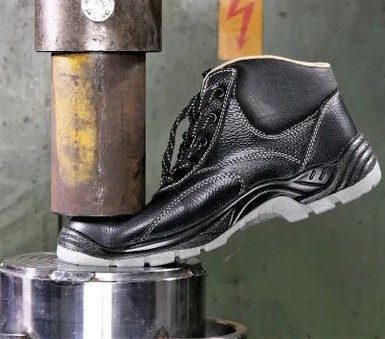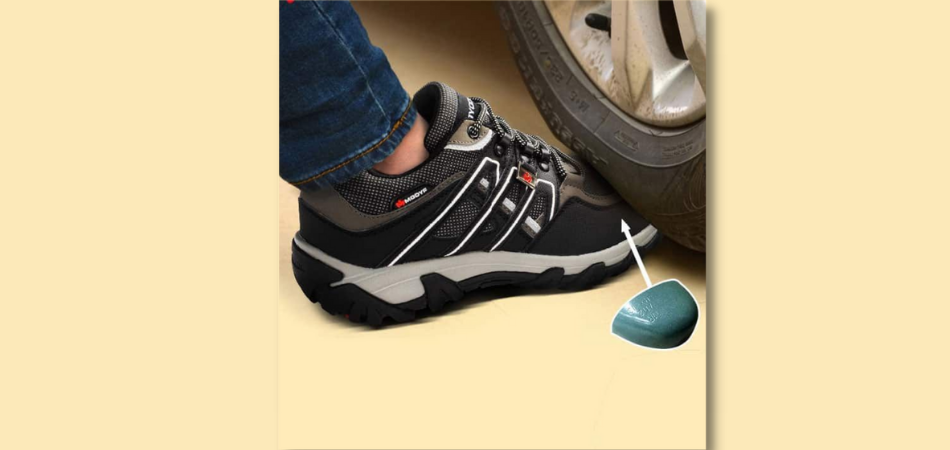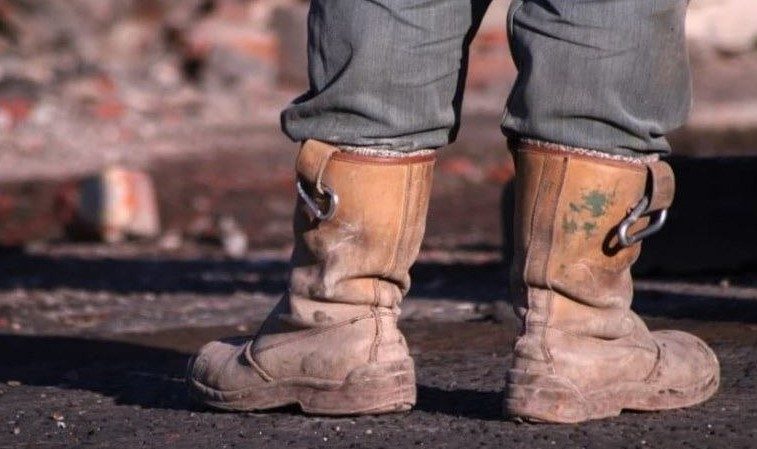When looking for a new pair of safety boots, toe caps are an essential consideration. Toe caps come in two types- steel and composite- and understanding how much weight can a composite toe hold compared to steel will help you make an informed decision.
On average, a composite toe can handle a compression force of 2500lbs, leaving your toes with about an inch of safe space to escape accidents. For falling objects, it can sustain the impact up to 50 lbs. falling from a height of 0.5 meters.
Composite toe caps is now dominating the market for their many advantages over steel toe caps. They are flexible, lightweight, EH-rated, all the while offering excellent safety.
If you have been wondering how much weight a composite toe holds, look no further. This article discusses all about composite toes, how much weight they hold, factors affecting how much weight they can hold, and who needs a composite toe.
Stay with us till the end.
What Is A Composite Toe In Footwear?
Composite toe refers to the safety toe caps that shield your forefoot while working in hazardous environments.
Generally, composite material is made by mixing several non-metal components. Then it is molded and hardened into a more robust final product, stronger than regular plastic, aluminum, or wood. This final product is a strong composition material, thus the name “composite.”
Nowadays, composite toes are widely used due to their lightweight and robust nature. They are affordable, safer, and provide enough foot protection, which is an essential requirement.
How Much Weight Can A Composite Toe Hold?
Most people tend to think that since composite toes are made from lighter than steel material, they withstand less load and are less durable. This is incorrect.
Even though composite toe caps are “non-metallic,” they can withstand pretty much equal or occasionally more load than their steel counterparts. And since they are lightweight, they are much more comfortable with better forefoot protection.
Like traditional steel toe caps, a composite toe can sustain a weight load of 2500 lbs. (1.1 metric tons). And you can test out the weight capacity quite easily.
For example, when a heavy forklift passes over your foot two or three times, your composite toe might not even bend! I know it sounds insane, but trust me with this one. Only this fact is sufficient to prove that composite toe caps are more secured and reliable than steel toe caps.
What Factors Affect How Much Weight Can A Composite Toe Hold?
A composite toe is a mixture of a number of components that make up one solid foot protection cap. These components include plastic, fiberglass, aramid, Kevlar, and carbon. One of the most significant factors affecting how much weight a composite toe can hold is the material used in the blended mixture.
While some manufacturers use more hardened plastic or TPU, others use more carbon fiber and Kevlar. Kevlar and carbon fiber caps can sustain more weight force and are considered the gold standard in the composite toe family.
Here are a few advantages of composite toes over their steel toes counterparts:
- Composite toes are 30% lighter than steel toe caps.
- They are more comfortable compared to steel toes.
- Composite toe caps offer electrical hazard protection.
- Unlike steel toe caps which conduct cold and freeze your foot, composite toes have cold insulation.
- Composite toe caps can easily pass-through metal detectors.
Is Composite Toe Stronger Than Steel Toe?
Well, there’s no doubt that steel is one of the most robust materials on earth.
A steel toe is stronger than a composite toe, however, they both can withstand almost equal measures of compression force. The robust nature of steel toes allows for the safety boot’s thinner and less bulbous finish. But composite toe caps have to be made thicker and more bulbous to enhance strength.
As safety toes are constantly advancing and getting better, more and more manufacturers are moving towards composite toes due to their numerous advantages. Below is a summary comparison chart between steel toes and composite toes.
| Property | Steel toe | Composite toe |
| Material | Steel | Fiberglass, carbon, plastic
|
| Weight | Heavier | Lightweight
|
| Comfortability | Less comfortable | More comfortable
|
| Cold weather | Conducts cold | Does not conduct cold
|
| Price | Affordable | Expensive
|
Do You Need Composite Toe Caps: What Jobs Need Composite Toe Safety?
As aforementioned, one of the most significant considerations when looking for protective/safety footwear is the level of protection it offers. This can be achieved by the use of composite or steel toe-capped boots.
It’s true that steel toe caps are imperative in the manufacturing and construction industries where workers face a high risk of heavy objects falling on their feet. But they are not suitable for all working environments.
Workers may opt for composite toe caps in workplaces where there isn’t such a higher risk. They are lightweight and non-metallic toe caps suitable for electricians, engineers, and independent contractors.
The primary reason is they do not conduct electricity. Composite toes safety boots are ideal for electrical hazard environments since they pass the ASTM electrical hazards tests.
Is Composite Toe Caps OSHA Approved?
Different workplaces have different safety precautions put in place for their workers; however, OSHA (Occupational Safety and Health Standards) and ASTM (American Society for Testing and Materials) are internationally recognized bodies that regulate workers’ safety in their workplaces. So, does composite toes meet OSHA requirements?
Yes. Composite toe-capped boots are OSHA and ASTM approved. They meet the safety requirements for use in almost all hazardous environments.
According to OSHA, the most common hazards that occur in workplaces include electrocution, slips, crushing, burns, puncture wounds, and chainsaw wounds. For this reason, they recommend workers in construction, shipping, logging, electricity, nuclear and similar industries wear proper PPE (Personal Protection Equipment) for protection against such hazards.
Composite toe boots meet all these safety requirements, therefore approved by OSHA. Their soles provide enough traction to prevent slipping on wet surfaces. Also, there are high arch work boots that are comfortable to wear for prolonged periods.
OSHA requires all workers in the earlier mentioned industries to wear only foot protection that complies with their safety standards.
Employers risk being fined if the safety standards are not met. Keep in mind that your workplace may have internal safety requirements that surpass OSHA’s minimum requirements.
Conclusion
How much weight can a composite toe hold may depend on the composite materials, however, the benefits of composite toe over steel toe can not be overlooked.
Composite toe caps are by far better, stronger, lighter, and safer yet affordable forefoot protection available in the market. In fact, manufacturers often claim composite toe as the new-age steel toe! They provide sufficient hardness and foot protection of up to 1.1 metric tons of force.
If you are looking for a lightweight and comfortable foot protection, a composite toe would be your best pick. After reading this article, we hope that you can make the right choice on the best toe protection for you.
If you work on a construction site, you may want to consider steel toe. However, a composite toe would work just fine for electricians, nuclear plant workers, or general home use.
And while you buy your safety boots, ensure they are OSHA and ASTM approved. Safety first; always keep those feet protected!!




